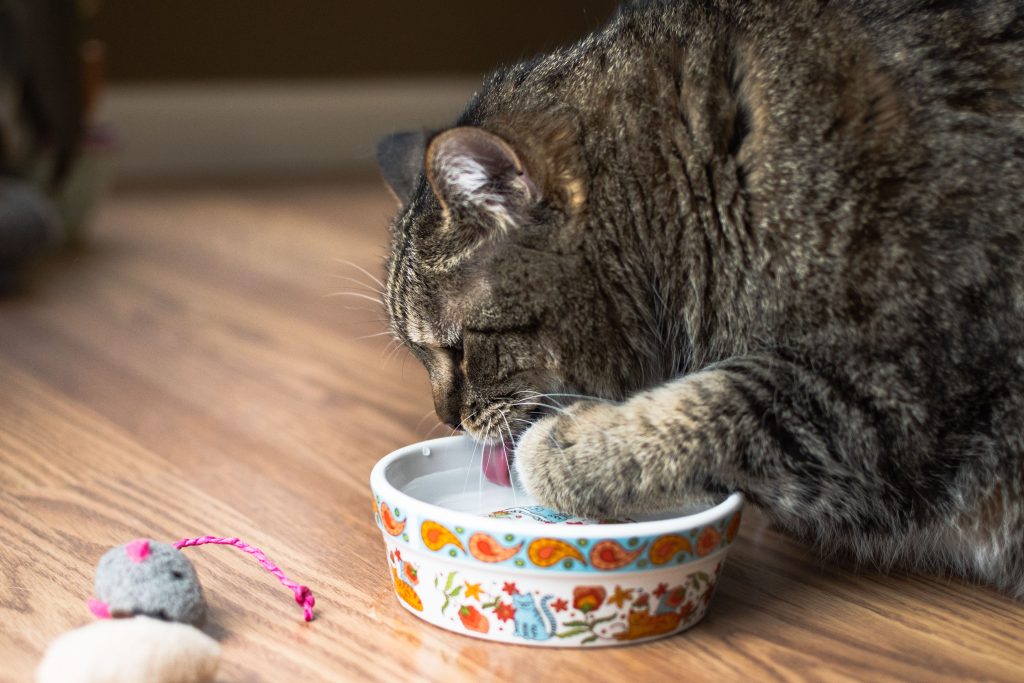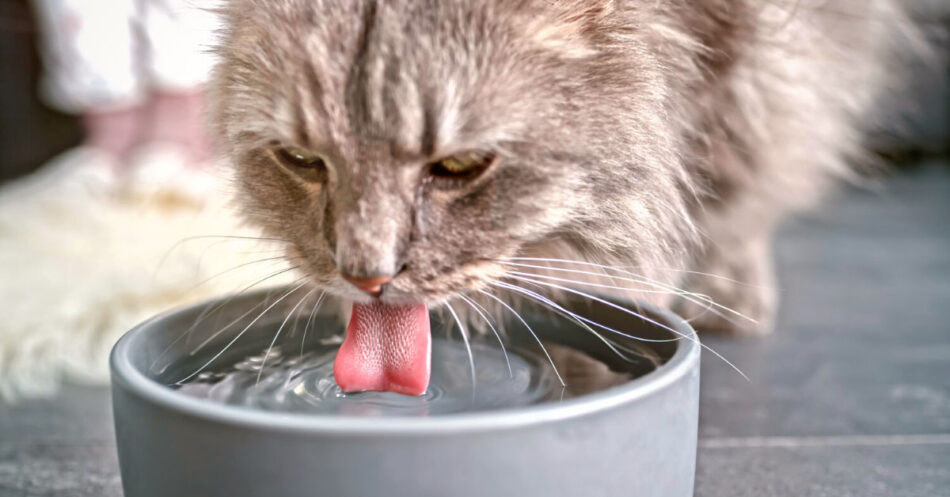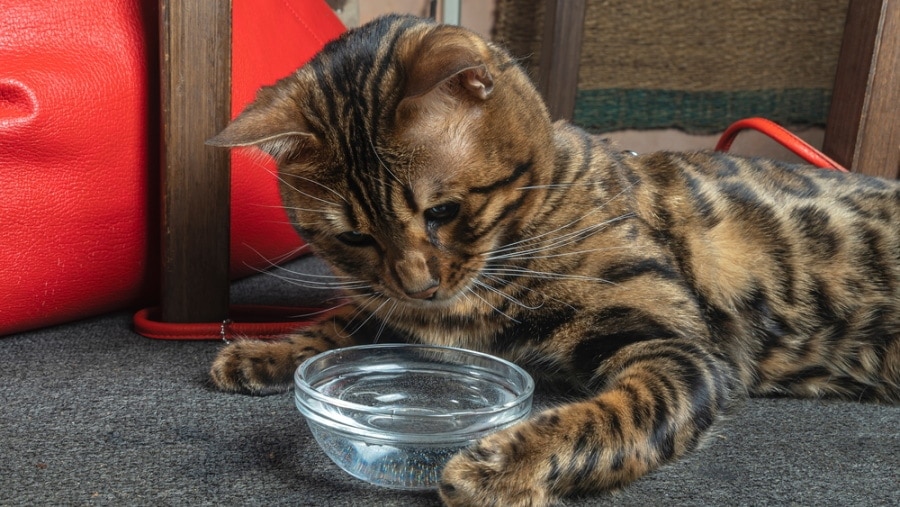The average cat doesn’t drink water much in the wild because its fluid needs come primarily from food. Most house cats continue to show natural behavior, even though they are used to living in a comfortable home where they are fully cared for. Therefore, it can easily happen that your cat doesn’t drink or doesn’t consume enough fluids. But does she completely cover her water needs through food? Or is their drinking behavior a cause for concern? We answer these and other questions.

Table of Contents
Natural reasons for a low require hydration
Cats naturally don’t have a great need for fluid intake, which distinguishes them from dogs and us humans. They are descended from the African fall cat, which originally lived in very dry areas. Today, wild cats are still used to meeting their fluid needs primarily through the water content and blood in their prey. You therefore no longer need to drink much. Nevertheless, a balanced water balance plays a major role in the health of cats.
Reasons why water is important
- Vital nutrient
- Solvents for substances that the body can then transport better
- Ensures that enzymes work
- Contributes, among other things, to the functioning of muscles, joints and eyes
- For example, it supports breathing, digestion and urination
In both wild and domestic cats, the water content in the body is approximately 50 to 70 percent. The exact value depends on the body fat content in adult animals. The higher this is, the lower the water content. The velvet paws lose water through excretions such as urine and feces, through breathing or, in lactating animals, through their mother’s milk. To compensate for this loss, cats need to drink enough water.
The water requirement depends on
- Age of the cat
- Type of feed and its composition
- physical exertion
- Water quality
- Diseases such as diarrhea, diabetes and kidney failure
- Temperatures at home and outdoors
On average, cats should drink 150 to 250 ml or 50 ml per body weight per day.

Water content in wet and dry food
If your cat is fed moist food, it is normal for him to hardly drink anything. The liquid contained in the food is around 80%, which corresponds roughly to the much water content of a mouse. Therefore the amount should normally be sufficient. Things are different if you give your cat dry rations. At an average of 7 to 10%, this hardly contains any ounce of water, which is why she has to consume this additionally.
TIP: When feeding moist food, you should not leave the food sitting at room temperature for a long time, otherwise it can easily spoil. This can cause your cat to vomit or have diarrhea. She shouldn’t eat all of her food straight away. The behavior is rooted in nature because wild cats catch and eat prey throughout the day. Therefore, there are some domestic cats that behave similarly and eat their food in portions.
Basically, there are harmless or natural causes if the cat doesn’t drink. However, a lack of fluids can cause serious problems as it can negatively affect the kidneys and urinary tract.

Monitor drinking behavior closely
If you are worried that your cat may not be drinking enough, this may not be true. This is particularly true for outdoor animals: When they are out and about, they often drink from puddles, birdbaths or other water sources. When they get home, they are no longer thirsty because they have already quenched it outdoors. Even with house cats, it can happen that you simply don’t notice that they are drinking. You can control this by always filling the water bowl up to a mark. If the bowl remains full every day, this could be an indication that your cat is not drinking. However, some velvet paws also have unusual drinking sources such as watering cans, flower vases or even the toilet.
Even if you are worried that your cat isn’t drinking enough, this isn’t necessarily true. This is particularly true for outdoor animals: When they are out and about, they often drink from puddles, birdbaths or other water sources. When they get home, they are no longer thirsty because they have already quenched it outdoors. Even with house cats, it can happen that you simply don’t notice that they are drinking. You can control this by always filling the water bowl up to a mark, provide fresh water. If the bowl remains full every day, this could be an indication that your cat is not drinking.

Reason why your cat isn’t drinking – when should you go to the vet?
It can always be a good idea to seek medical advice if your cat is likely to behave strangely. This is especially true if she is also not eating, is limp, and exhibits other abnormal behavior. Dehydration can easily occur in velvet paws if they are not getting enough water from their diet and naturally don’t drink much. Evidence for this is:
- Loss of appetite
- Lack of motivation
- Heavy breathing
- Deep-set eyes
- Dried, sticky gums
Skin turgor test You can check whether your cat is acutely dehydrated as follows: Take skin in the shoulder area between two fingers, pull gently and let go. Normally the skin should be tight again shortly afterwards. If you are dehydrated, this will take significantly longer.
A visit to the vet is also advisable if you notice that your cat has not drink as much as he should for some time. Metabolic products are excreted via fluid and urine. If this process occurs too rarely, the concentration of these substances in the body increases. This can have negative consequences for the cat’s health.
Encourage cat to drink
- If your cat doesn’t drink, you can motivate him to do so. To do this, keep showing her the water bowl.
- To make the water tastier and therefore more interesting, you can flavor it with salt-free broth or cat’s milk.
- The right place for the water bowl is not exactly next to the food bowl. It’s better to place this somewhere else because the animals don’t like to drink where they eat.
- The nature of the bowl also plays a role. It shouldn’t be too flat and shouldn’t slide around too much. A non-slip mat as a base, for example, can prevent this.
- It can also help to clean the bowl with hot water every day to remove odors. Then fill it with fresh water.
- Some animals prefer fresh water, others prefer stale water. Others like to drink from a cat fountain. So you have to try out what it’s like for your four-legged friend.
- To get your cat drink water more, you can also give him liquid in his food. However, it can happen that very picky animals no longer eat it (for now).
- If their cat doesn’t drink, many owners use the following trick: They wet their fur. She will then immediately begin to lick it dry and thereby absorb liquid.
- If you live in an area where tap water is chlorinated, it is better to use rainwater or still mineral water.
- Do not give your cat any cow’s milk. Your digestive system cannot process the lactose it contains, which can lead to diarrhea and vomiting.

How to rehydrate a cat?
Rehydrating a cat is important if you suspect they are dehydrated due to illness, heat, or other factors. Dehydration can be a serious condition and requires prompt attention. If you suspect your cat is dehydrated, follow these steps:
- Recognize the Signs of Dehydration:
- Common signs include lethargy, sunken eyes, dry or tacky gums, loss of skin elasticity, and reduced urine output. If you notice these signs, your cat may be dehydrated.
- Encourage Drinking:
- Offer your cat purified water. Some cats prefer running water, so using a cat water fountain can be enticing. You can also try offering ice cubes, as some cats enjoy playing with them and licking the melting water.
- Offer Wet Food:
- Wet cat food has a higher moisture content than dry rations, and it can help increase your cat’s fluid intake. If your cat is not eating, you can try offering moist food on its own or mixed with a little water.
- Pedialyte or Electrolyte Solution:
- In cases of mild dehydration, you can offer a small amount of unflavored Pedialyte or a veterinary-approved electrolyte solution. Use a syringe or dropper to administer small amounts at a time.
- Consult Your Veterinarian:
- If your cat is severely dehydrated or if the dehydration persists, consult your veterinarian immediately. Dehydration can be a symptom of an underlying health issue, and professional veterinary care is crucial.
- Vet-Approved Rehydration Solutions:
- Your veterinarian may recommend prescription or over-the-counter rehydration solutions designed specifically for cats. Follow your vet’s instructions regarding dosage and administration.
- Administer Fluids Under Veterinary Supervision:
- In severe cases of dehydration, your veterinarian may recommend administering fluids subcutaneously (under the skin) or intravenously (directly into the vein). This should only be done by a veterinarian or under their supervision.
- Monitor Your Cat’s Condition:
- Keep a close eye on your cat’s behavior and overall condition. If there is no improvement or if the dehydration worsens, seek immediate veterinary attention.
It’s important to note that dehydration can be a symptom of various underlying issues, including kidney disease, diabetes, or gastrointestinal problems. Professional veterinary assessment is crucial to identify and address the root cause of dehydration.
If you suspect your cat is dehydrated or exhibiting signs of illness, it’s always best to consult with your veterinarian promptly for a proper diagnosis and appropriate treatment.
How long does it take a cat to recover from dehydration?
The time it takes for a cat to recover from dehydration depends on the severity of the dehydration and the underlying cause. Mild cases of dehydration can often be addressed at home with prompt intervention, while more severe cases may require veterinary treatment and monitoring. Here are some general considerations:
- Mild Dehydration:
- If dehydration is caught early and is considered mild, a cat can often start showing improvement within a day or two with appropriate measures like offering water, moist food, or rehydration solutions.
- Moderate Dehydration:
- Cats with moderate dehydration may take a few days to a week to fully recover. Veterinary intervention may be necessary to administer fluids, and your cat’s progress will be monitored during this time.
- Severe Dehydration:
- In cases of severe dehydration, recovery may take longer. Cats may require more intensive veterinary care, including intravenous fluid therapy. The duration of recovery will depend on the underlying cause and the response to treatment.
- Underlying Health Conditions:
- If dehydration is a symptom of an underlying health condition, such as kidney disease, diabetes, or gastrointestinal issues, the recovery time will be influenced by the successful management of the primary condition.
- Veterinary Monitoring:
- Cats recovering from dehydration may need ongoing veterinary monitoring to ensure they are rehydrating properly, maintaining hydration, and showing improvement in overall health.
It’s crucial to note that dehydration is often a symptom rather than a standalone condition. The underlying cause needs to be identified and addressed for complete recovery. If your cat is dehydrated, it’s strongly recommended to seek veterinary attention promptly. During the recovery period, it’s important to provide a comfortable and stress-free environment for your cat. Ensure they have access to purified water at all times, and monitor their food intake. Follow any dietary recommendations or medication instructions provided by your veterinarian.
Always consult with your veterinarian for personalized advice based on your cat’s specific condition and health history. Early intervention and professional veterinary care are key factors in the successful recovery of a dehydrated cat.

What happens when cat is dehydrated?
Dehydration in cats occurs when the body loses more fluids than it takes in, leading to an insufficient amount of water to support normal bodily functions. It can be caused by various factors, including illness, heat, insufficient water intake, or underlying health conditions. Here are some common signs and consequences of dehydration in cats:
Signs of Dehydration:
- Lethargy:
- Dehydrated feline might appear more lethargic than usual. They might be less active, sleep more, and show a lack of interest in their surroundings.
- Dry or Tacky Gums:
- Healthy cats have moist gums. Dehydrated feline might have dry or tacky gums, indicating a lack of hydration.
- Sunken Eyes:
- The eyes may appear sunken or dull in a dehydrated cat. The eye tissues lose their usual turgor due to insufficient fluid.
- Reduced Skin Elasticity:
- Pinch a small amount of skin on the back of the cat’s neck. In well-hydrated cats, the skin quickly returns to its normal position. Dehydrated feline might have reduced skin elasticity, and the skin may take longer to return to its place.
- Loss of Appetite:
- Dehydrated feline might show a decreased interest in food. This can lead to weight loss if the condition persists.
- Urine Changes:
- Dehydration can result in concentrated urine. You may notice a decrease in the frequency of urination, and the urine may appear darker in color.
- Panting:
- Cats may pant as a response to dehydration, especially in hot weather. However, excessive panting can also indicate other health issues.
- Collapse or Weakness:
- Severe dehydration can lead to weakness, collapse, or an inability to stand.
Consequences of Dehydration:
- Organ Dysfunction:
- Dehydration can affect the normal functioning of organs, including the kidneys and liver. Prolonged dehydration may lead to organ damage.
- Electrolyte Imbalance:
- Loss of fluids also results in the loss of electrolytes. Electrolyte imbalance can negatively impact various physiological processes.
- Urinary Tract Issues:
- Dehydration can contribute to urinary tract problems, such as the formation of crystals or stones.
- Heat Stroke:
- In hot weather, dehydration increases the risk of heat stroke, which can be life-threatening.
- Decreased Blood Volume:
- Reduced fluid levels in the body lead to decreased blood volume, affecting blood circulation and overall cardiovascular health.
It’s important to note that dehydration can be a symptom of an underlying health condition, such as kidney disease, diabetes, or gastrointestinal issues. If you suspect your cat is dehydrated, prompt veterinary attention is crucial to identify the cause and implement appropriate treatment measures, which may include fluid therapy and addressing the underlying condition.
Conclusion
Unlike dogs or people, cats drink little because they get their water needs through food. If your cat gets wet food, the liquid it contains is usually enough. If you prefer dry rations, you should make sure that your cat gets enough liquid. If your cat doesn’t drink or doesn’t drink enough, you should watch it closely. If in doubt, you can do a skin turgor test to see if she is dehydrated. There are also a number of tricks you can use to encourage your cat to take in fluids.
FAQs
Q: Why is my cat not drinking water?
A: There could be several reasons why your feline might not be drinking enough water. It could be due to a health issue, diet, or environmental factors.
Q: What are the possible health issues that can cause my cat to not drink water?
A: Health issues such as kidney disease, urinary tract infections, diabetes, or dental problems can cause cats to drink less water than usual.
Q: How much water should my cat drink in a day?
A: Cats typically need for fluid intake about 3.5-4.5 ounces of water per 5 pounds of body weight per day. However, this can vary based on their diet and activity levels.
Q: My cat eats wet food, does that mean they don’t need as much water?
A: Cats that eat wet food get some of their water intake from the food, but it’s still important to provide fresh water daily to ensure they stay properly hydrated.
Q: What can I do to encourage my cat to drink more water?
A: You can try offering different water sources, placing drinking bowls in multiple locations, using a cat fountain, or adding water to their food to increase their water intake.
Q: How can I tell if my cat is dehydrated?
A: You can check for signs of dehydration such as dry gums, sunken eyes, lethargy, or a loss of skin elasticity. If you suspect your cat is dehydrated, consult a veterinarian.
Q: Is it normal for my cat to not drink as plenty of water during winter?
A: Feline might drink less water during colder months, as they are less likely to feel thirsty. However, it’s important to ensure they still have access to purified water.
Q: What are some tips for increasing my cat’s water consumption?
A: You can try offering a variety of water sources such as bowls or fountains, providing multiple drinking bowls in different areas of the house, and ensuring the water is always fresh and clean.
Q: Should I be concerned if my cat doesn’t drink water while eating dry food?
A: Some feline might not drink as plenty of water when eating dry food, as they can get moisture from their food. However, it’s still important to monitor their water intake and consult a vet if you are concerned.
Q: How do I know if my cat is drinking enough water?
A: You can monitor your cat’s water intake by measuring how plenty of water is being consumed each day. Additionally, you can observe their litter box habits and look for signs of dehydration.